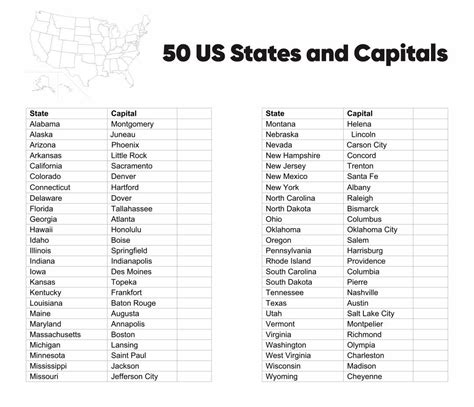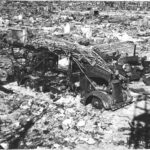
A traveler who visited all 50 U.S. state capitals in 30 days has identified Trenton, New Jersey, and Springfield, Illinois, as the two “worst” capitals based on factors like walkability, safety, and overall appeal. TikTok user @travelingwiththierry, real name Thierry, documented his ambitious journey, offering insights into each city and sparking debate about his assessments.
Thierry’s cross-country journey, motivated by a desire to experience American culture beyond major tourist destinations, culminated in a ranking of the state capitals from best to worst. While acknowledging the unique charm and historical significance of each location, Thierry cited Trenton and Springfield as particularly underwhelming. His criteria focused on the immediate experience of a visitor, prioritizing pedestrian-friendliness, perceived safety, and the availability of engaging attractions.
Trenton, New Jersey, drew criticism primarily for its perceived lack of walkability and visible signs of urban decay. Thierry’s video showcased deserted streets and a general sense of unease, leading him to conclude it was the “worst” capital he visited. He noted a dearth of pedestrian activity and a feeling of isolation.
Springfield, Illinois, while possessing historical importance as the home of Abraham Lincoln, suffered in Thierry’s estimation from a perceived lack of vibrancy and engaging attractions beyond its Lincoln-related sites. He described the city as feeling “dead” after 5 p.m. and expressed disappointment with the overall atmosphere. He also cited difficulty finding open establishments and a general lack of excitement.
Thierry emphasized that his assessments were subjective and based on his personal experiences during a brief visit to each capital. He encouraged viewers to form their own opinions and acknowledged that many factors beyond his immediate observations contribute to the character of each city. His journey and rankings have ignited discussions about the realities of state capitals often overlooked in favor of larger metropolitan areas.
The Ambitious Journey: 50 Capitals in 30 Days
Thierry’s motivation for the whirlwind tour stemmed from a desire to explore the authentic heart of America, bypassing the typical tourist hotspots. He aimed to immerse himself in the unique character of each state capital, gaining a firsthand understanding of their history, culture, and daily life. The journey was meticulously planned to maximize efficiency, involving a combination of flights, trains, and rental cars.
Documenting his experiences on TikTok, Thierry provided brief glimpses into each capital, highlighting notable landmarks, local eateries, and overall impressions. His videos, often featuring quick cuts and upbeat music, offered a snapshot of each city’s atmosphere. While acknowledging the limitations of his short visits, he strived to capture the essence of each capital and share his observations with his online audience.
The logistical challenges of visiting all 50 capitals in just 30 days were significant. Thierry faced tight schedules, long travel days, and the constant pressure to stay on track. He relied on careful planning and efficient transportation to maintain his ambitious pace. Despite the demanding nature of the journey, he remained enthusiastic and committed to completing his goal.
Trenton, New Jersey: A Capital Under Scrutiny
Trenton, the capital of New Jersey, has long grappled with challenges related to urban development, economic revitalization, and public safety. While possessing a rich history and strategic location along the Delaware River, the city has faced difficulties in attracting investment and fostering a vibrant downtown area. Thierry’s assessment of Trenton as the “worst” capital reflects these underlying issues and highlights the need for renewed efforts to improve the city’s image and quality of life.
“I didn’t feel safe walking around,” Thierry stated in his video about Trenton, encapsulating his primary concern. He elaborated on the lack of pedestrian activity and the presence of visible signs of neglect, contributing to a sense of unease. His observations align with broader concerns about Trenton’s downtown area, which has struggled to maintain a thriving commercial presence.
Efforts to revitalize Trenton have included initiatives to attract new businesses, improve infrastructure, and enhance public safety. However, progress has been slow and uneven, and the city continues to face significant challenges. Thierry’s assessment serves as a reminder of the importance of addressing these issues and creating a more welcoming and vibrant environment for residents and visitors alike.
Springfield, Illinois: Beyond Lincoln’s Legacy
Springfield, Illinois, is inextricably linked to the legacy of Abraham Lincoln, who spent a significant portion of his life in the city. While Lincoln-related historical sites remain a major draw for tourists, Springfield faces the challenge of diversifying its attractions and creating a more dynamic and engaging experience for visitors beyond its historical landmarks. Thierry’s assessment of Springfield as the second “worst” capital underscores this challenge and highlights the need for the city to reinvent itself.
Thierry expressed disappointment with the overall atmosphere of Springfield, describing it as feeling “dead” after 5 p.m. He noted the difficulty in finding open establishments and a general lack of excitement, suggesting that the city struggles to maintain a vibrant nightlife and entertainment scene. His observations point to the need for Springfield to attract new businesses, develop new attractions, and create a more appealing environment for residents and visitors alike.
Efforts to revitalize Springfield have included initiatives to promote tourism, attract new businesses, and improve the city’s infrastructure. The city has also invested in developing new attractions, such as the Abraham Lincoln Presidential Library and Museum, to enhance its appeal to visitors. However, more needs to be done to create a more diverse and dynamic economy and a more vibrant and engaging experience for residents and visitors alike.
Subjectivity and Perspective: The Limitations of a Quick Visit
Thierry acknowledged the subjective nature of his assessments and emphasized that his rankings were based on his personal experiences during a brief visit to each capital. He recognized that many factors beyond his immediate observations contribute to the character of each city and that his perspective may not fully reflect the complexities of each location. He encouraged viewers to form their own opinions and to explore the state capitals for themselves.
The limitations of a quick visit are undeniable. Thierry’s brief stays in each capital allowed him to capture a snapshot of the city’s atmosphere and to observe its most prominent features. However, he lacked the time to delve deeply into the city’s history, culture, and social dynamics. His assessments were necessarily based on superficial impressions and may not fully reflect the realities of life in each capital.
Despite these limitations, Thierry’s journey provides a valuable perspective on the state capitals and highlights the importance of considering the visitor experience when evaluating the quality of life in a city. His observations can serve as a catalyst for discussion and inspire efforts to improve the appeal and vibrancy of state capitals across the country.
The Broader Implications: Overlooked Capitals and Urban Development
Thierry’s journey has sparked a broader discussion about the realities of state capitals often overlooked in favor of larger metropolitan areas. Many state capitals face challenges related to economic development, urban revitalization, and public safety. These challenges can be exacerbated by a lack of attention and investment, leading to a decline in the city’s overall quality of life.
Thierry’s assessments of Trenton and Springfield highlight the importance of addressing these challenges and investing in the revitalization of state capitals. By creating more vibrant and engaging environments, state capitals can attract new residents, businesses, and tourists, boosting their economies and improving their overall quality of life.
The lessons learned from Thierry’s journey can be applied to other state capitals across the country. By focusing on improving walkability, enhancing public safety, and developing new attractions, state capitals can create more welcoming and vibrant environments for residents and visitors alike.
Detailed breakdown of problems in Trenton and Springfield
- Trenton, New Jersey:
- Walkability and Safety: The primary issue Thierry highlighted was the lack of pedestrian-friendly infrastructure and a general feeling of unsafety. This can be attributed to several factors, including:
- Urban Sprawl and Car Dependency: Trenton, like many older cities, has struggled with adapting to the increasing reliance on automobiles. This has often led to prioritizing roads over pedestrian walkways and public transportation.
- Economic Decline: Economic hardship can lead to underfunding of public services like street maintenance and policing, contributing to a perception of unsafety and neglect. Abandoned buildings and vacant lots further contribute to this atmosphere.
- Lack of Investment in Public Spaces: Insufficient investment in parks, plazas, and other public spaces can limit opportunities for community gathering and recreation, making the city less appealing to residents and visitors.
- Lack of Activity and Attractions: Thierry mentioned the lack of things to do, indicating a need for more diverse attractions and activities beyond government buildings.
- Limited Entertainment Options: A lack of restaurants, shops, and entertainment venues, particularly in the evening, can make a city feel lifeless and uninviting.
- Insufficient Promotion of Existing Attractions: Even if attractions exist, they may not be effectively promoted or easily accessible to tourists.
- Walkability and Safety: The primary issue Thierry highlighted was the lack of pedestrian-friendly infrastructure and a general feeling of unsafety. This can be attributed to several factors, including:
- Springfield, Illinois:
- “Dead” After 5 PM: This suggests a lack of a vibrant nightlife and a limited number of businesses open during evening hours.
- Economic Stagnation: If businesses close early or don’t operate in the evenings, it can be a sign of economic stagnation, potentially driven by declining population or a lack of consumer demand.
- Lack of Investment in Downtown Revitalization: A lack of investment in downtown areas can lead to a decline in businesses and a less appealing environment for residents and visitors.
- Over-Reliance on Lincoln History: While Lincoln’s legacy is a significant asset, the city may need to diversify its offerings to appeal to a wider range of interests.
- Need for Diverse Attractions: Focusing solely on historical attractions can limit the appeal to visitors who may be interested in other activities like arts, culture, outdoor recreation, or dining.
- Marketing and Promotion: The city may need to improve its marketing efforts to promote attractions beyond the Lincoln-related sites.
- Difficulties Finding Open Establishments: This reinforces the issue of limited business hours and a lack of activity in the city.
- Business Climate: Factors like high taxes, regulations, or a lack of skilled workforce can make it difficult for businesses to thrive and stay open.
- Retail and Restaurant Options: A limited selection of retail and restaurant options can make the city less appealing to residents and tourists.
- “Dead” After 5 PM: This suggests a lack of a vibrant nightlife and a limited number of businesses open during evening hours.
Contributing Factors and Potential Solutions:
Both cities face unique challenges, but some common factors contribute to their perceived shortcomings. Addressing these issues requires a multifaceted approach involving government, businesses, and community organizations.
- Economic Development:
- Attracting New Businesses: Implementing policies that encourage investment, such as tax incentives and streamlined permitting processes, can attract new businesses and create jobs.
- Supporting Existing Businesses: Providing resources and support to existing businesses, such as access to capital and training programs, can help them thrive and expand.
- Diversifying the Economy: Reducing reliance on a single industry can make the city more resilient to economic downturns.
- Urban Planning and Infrastructure:
- Improving Walkability: Investing in pedestrian-friendly infrastructure, such as sidewalks, crosswalks, and bike lanes, can make the city more accessible and appealing to pedestrians.
- Enhancing Public Transportation: Improving public transportation options, such as buses and trains, can reduce reliance on cars and make the city more accessible to residents and visitors.
- Beautifying Public Spaces: Investing in parks, plazas, and other public spaces can create more attractive and welcoming environments for residents and visitors.
- Public Safety:
- Increasing Police Presence: Increasing police presence and visibility can deter crime and make residents and visitors feel safer.
- Improving Community Policing: Building relationships between police and the community can improve trust and cooperation in crime prevention.
- Addressing Root Causes of Crime: Addressing issues like poverty, unemployment, and lack of access to education can help reduce crime in the long term.
- Tourism and Marketing:
- Promoting Attractions: Developing and promoting a diverse range of attractions, including historical sites, cultural institutions, and outdoor recreation opportunities, can attract more visitors.
- Improving Marketing Efforts: Using targeted marketing campaigns to reach potential visitors can increase awareness of the city and its attractions.
- Enhancing the Visitor Experience: Providing excellent customer service and ensuring that visitors have a positive experience can encourage them to return and recommend the city to others.
Conclusion:
Thierry’s journey through the 50 U.S. state capitals offers a unique perspective on the overlooked realities of many American cities. While his assessments of Trenton and Springfield are subjective and based on brief visits, they highlight important challenges related to economic development, urban planning, public safety, and tourism. Addressing these challenges requires a comprehensive and collaborative effort involving government, businesses, and community organizations. By investing in revitalization efforts and creating more vibrant and welcoming environments, state capitals can attract new residents, businesses, and tourists, boosting their economies and improving their overall quality of life. The discussion sparked by Thierry’s travels serves as a valuable reminder of the importance of investing in all American cities, not just the most well-known metropolises. The value lies not just in tourism, but also in providing a decent quality of life for all citizens. Frequently Asked Questions (FAQ)
1. What criteria did @travelingwiththierry use to rank the state capitals?
Thierry primarily focused on walkability, safety, and the overall appeal of the city as experienced during a short visit. He considered factors such as pedestrian-friendliness, the presence of engaging attractions, and the general atmosphere of the city. He explicitly stated that his opinions were subjective and based on his personal experiences.
2. Why were Trenton, New Jersey, and Springfield, Illinois, identified as the “worst” capitals?
Trenton was criticized for its perceived lack of walkability and safety, with Thierry citing deserted streets and a general sense of unease. Springfield was seen as lacking vibrancy and engaging attractions beyond its Lincoln-related sites, feeling “dead” after 5 p.m. Both assessments were based on Thierry’s subjective experiences.
3. How accurate and reliable are Thierry’s assessments, considering the brief nature of his visits?
Thierry himself acknowledged the limitations of his short visits and the subjective nature of his assessments. While his observations provide a snapshot of each city, they may not fully reflect the complexities and nuances of life in each capital. Factors such as the time of day, weather conditions, and personal preferences could have influenced his perceptions. Therefore, his assessments should be considered as one perspective among many. They can also serve as a springboard for broader discussions about what improvements cities need.
4. What are some potential solutions to address the issues highlighted in Trenton and Springfield?
Potential solutions include investing in urban revitalization projects, improving infrastructure, enhancing public safety measures, attracting new businesses, promoting tourism, and creating more vibrant and engaging environments for residents and visitors alike. Specifically, improving walkability, increasing police presence, diversifying local economies, and adding more options for nightlife are all good places to start.
5. What is the significance of Thierry’s journey and the resulting discussion about state capitals?
Thierry’s journey has brought attention to the often-overlooked realities of many state capitals, sparking a broader discussion about the challenges they face and the importance of investing in their revitalization. It highlights the need to consider the visitor experience and to create more welcoming and vibrant environments for residents and tourists alike.









